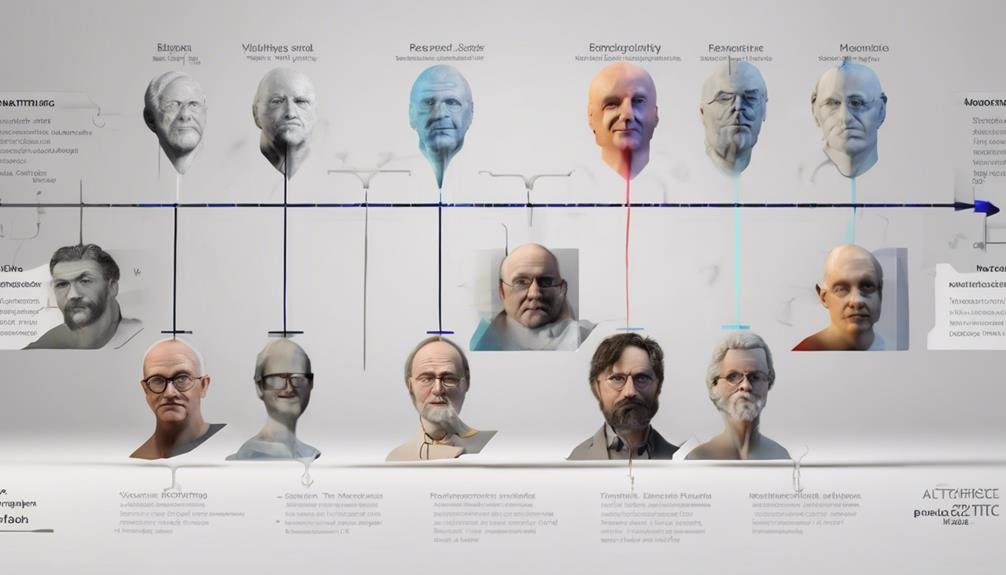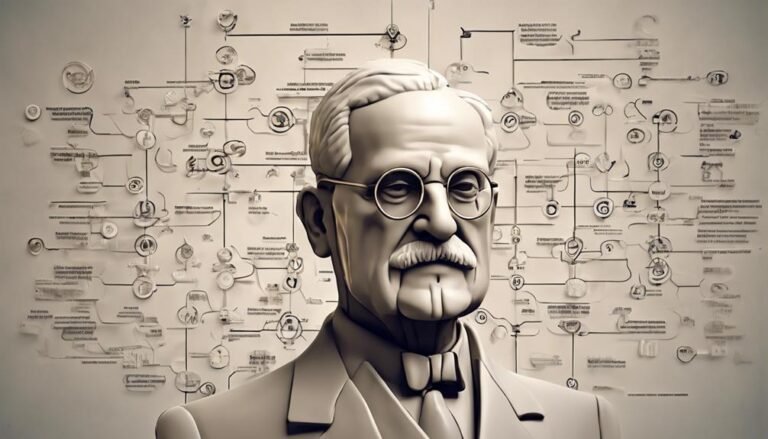The Development of Personality Research Methods
As you explore the domain of personality research methods, you'll find a fascinating journey through the evolution of techniques used to unravel the mysteries of human personality. From the rudimentary trait theories to the intricate interplay of biological and genetic influences, each method has added a layer of understanding to this complex puzzle. The application of advanced technological tools has opened new avenues for exploration, hinting at even more profound insights waiting to be uncovered. What lies ahead in the ever-evolving landscape of personality research is a domain of possibilities that promises to reshape our understanding of what makes us who we are.
Key Takeaways
- Early methods included trait theories, case studies, self-report measures, and interviews.
- Psychometric testing standardized personality assessments with reliability and validity measures.
- Behavioral observation techniques improved direct assessment with ethical considerations.
- Projective tests like inkblots and thematic apperception tests explored subconscious aspects of personality.
- Integration of biological and genetic studies enhanced understanding of physiological and genetic influences on personality.
Early Personality Measurement Techniques
Early personality measurement techniques emerged in the late 19th and early 20th centuries as researchers sought to quantify and understand the complexities of human personality. Trait theories played a significant role during this period, aiming to identify and measure fundamental characteristics that make up an individual's personality.
Case studies were commonly used to explore specific individuals' behaviors, emotions, and thought patterns, providing valuable insights into personality dynamics.
Self-report measures were another important method employed to assess personality traits. Individuals would directly respond to questionnaires or surveys about themselves, offering researchers a way to gather data on various aspects of personality.
Interviews also became a popular tool for understanding personality, as they allowed researchers to interact directly with subjects, observe their responses, and gain a deeper understanding of their traits and behaviors.
These early techniques laid the foundation for future advancements in personality research, shaping the way psychologists approached the study of human personality.
Emergence of Psychometric Testing
The emergence of psychometric testing revolutionized personality research by introducing standardized methods for quantifying and analyzing individual traits and characteristics. Psychometric testing involves the use of statistical analysis to measure psychological traits.
One important aspect of psychometric testing is reliability testing, which assesses the consistency and stability of the measurements taken. This guarantees that the results obtained are dependable and not influenced by random factors.
Moreover, standardized assessments are a key component of psychometric testing, providing a uniform way to measure personality traits across different individuals. Validity measures are also essential in psychometric testing, ensuring that the tests accurately measure what they're intended to measure.
Introduction of Behavioral Observation Methods
Implementation of behavioral observation methods in personality research enhances the ability to directly assess and analyze individuals' actions and interactions in varied contexts. Ethical considerations play an important role in guaranteeing that observational techniques are conducted in a responsible and respectful manner. Researchers must obtain informed consent from participants, maintain confidentiality, and minimize any potential harm or discomfort during observations.
Observational techniques may involve naturalistic observation, where individuals are observed in their everyday environments without interference, or structured observation, where specific behaviors are systematically recorded in controlled settings.
The use of video recordings, behavior checklists, and coding systems can help standardize the observational process and ensure reliability and validity of the data collected.
Incorporation of Projective Tests
To broaden the scope of personality research methods, incorporating projective tests offers a unique approach to uncovering underlying thoughts, emotions, and motivations of individuals. Two prominent projective tests commonly used in personality assessment are the Rorschach inkblots and thematic apperception tests.
These tests are widely employed in clinical psychology to explore the subconscious aspects of an individual's personality. The Rorschach inkblots, consisting of ambiguous images, allow clinicians to analyze the responses of individuals to reveal their thought processes and emotional tendencies.
On the other hand, thematic apperception tests present individuals with vague images, prompting them to create stories, which can provide insights into their motivations and beliefs.
Integration of Biological and Genetic Studies
Utilizing advanced genetic and biological research methods enhances the depth and accuracy of personality assessments, offering valuable insights into the underlying physiological and genetic factors influencing individual traits and behaviors. Biological factors play an essential role in shaping personality, with research indicating that variations in neurotransmitter levels, brain structure, and hormonal regulation can impact an individual's predisposition to certain traits.
Genetic influences also play a substantial part in the development of personality, as evidenced by studies highlighting the heritability of traits such as extraversion, neuroticism, and openness to experience. By integrating biological and genetic studies into personality research, researchers can gain a more thorough understanding of how nature and nurture interact to mold an individual's character.
Through methods like twin studies, genome-wide association studies, and neuroimaging techniques, scientists can unravel the complex interplay between genetic predispositions and environmental influences in shaping personality traits. This integrative approach paves the way for a more detailed and holistic understanding of the intricate mechanisms underlying human personality.
Utilization of Big Data and Technology
You can explore the significant impact of big data analysis on understanding personality traits, shedding light on patterns and correlations that mightn't be evident through traditional research methods.
Technological advancements have revolutionized how researchers study personality, allowing for more sophisticated data processing and analysis techniques.
Big Data Analysis
Incorporating big data analysis techniques into personality research has revolutionized the field by providing researchers with unprecedented access to vast amounts of behavioral data for in-depth analysis and pattern recognition.
Machine learning algorithms play an essential role in sifting through large datasets to identify complex patterns and trends that may not be apparent through traditional methods. Data mining techniques enable researchers to uncover hidden insights and relationships within the data, allowing for a deeper understanding of personality traits and behaviors.
Through the utilization of big data analysis, researchers can now analyze behavioral patterns on a scale never before possible, leading to more accurate predictions and personalized interventions.
The integration of advanced technology in personality research has opened up new avenues for exploring individual differences and psychological dynamics. By harnessing the power of big data and machine learning, researchers can explore the complexities of human behavior with a level of detail and precision that was previously unattainable.
Technological Advancements
The integration of big data and technology has greatly enhanced the capabilities of personality researchers to analyze behavioral data with unprecedented depth and accuracy. Data analytics tools have allowed researchers to sift through vast amounts of information efficiently, identifying patterns and trends that were previously inaccessible.
Machine learning algorithms play a vital role in processing this data, enabling researchers to generate insights and predictions based on complex datasets.
Through the utilization of technology, personality researchers can now explore nuanced aspects of behavior and personality traits, leading to a more extensive understanding of human psychology. These advancements haven't only expedited the research process but have also improved the quality and reliability of findings.
Data Collection Techniques
Utilizing big data and technology in data collection techniques revolutionizes the way personality researchers gather and analyze behavioral data. Survey analysis, qualitative interviews, ethnographic studies, and case studies are now enhanced through the utilization of advanced technological tools.
Surveys conducted online can reach larger and more diverse populations, providing a broader range of responses for analysis. Qualitative interviews can be recorded, transcribed, and analyzed using software that identifies patterns and themes efficiently. Ethnographic studies benefit from digital tools that enable researchers to collect, organize, and analyze observational data in real-time.
Additionally, technology allows for the integration of multimedia elements in case studies, providing a richer understanding of individual experiences. Overall, the incorporation of big data and technology in data collection techniques offers researchers unprecedented access to vast amounts of behavioral data, streamlining the research process and enhancing the depth and accuracy of personality studies.
Future Trends in Personality Research
Advancements in technology continue to shape the future landscape of personality research methodologies. Longitudinal studies, essential for tracking changes over time, will become more sophisticated with the integration of big data analytics and machine learning algorithms.
Cross-cultural comparisons will benefit from advancements in communication technologies that enable real-time data collection across diverse populations.
Meta-analysis techniques will be further refined to synthesize findings from multiple studies, providing a more thorough understanding of personality traits across different contexts. Predictive modeling, leveraging artificial intelligence and advanced statistical methods, will allow researchers to forecast personality development trajectories with greater accuracy.
The future of personality research will also see an increased emphasis on interdisciplinary collaborations, combining psychology with fields such as neuroscience, sociology, and computer science. This interdisciplinary approach will foster innovative research designs and methodologies, leading to a more detailed understanding of personality dynamics in an ever-evolving society.
Conclusion
As you reflect on the evolution of personality research methods, you may find it coincidental that technological advancements have coincided with a deeper understanding of physiological and genetic influences.
With the integration of advanced machine learning algorithms and artificial intelligence, future trends in personality research are poised to reveal even more intricate insights into individual differences and behaviors.
The intersection of science and technology continues to shape the landscape of personality research, paving the way for new discoveries and advancements in the field.







